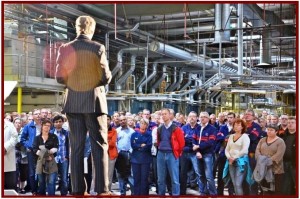Swedish Automobile N.V. (NYSE Euronext Amsterdam: SWAN) announced that Saab Automobile AB and its subsidiaries Saab Automobile Powertrain AB and Saab Automobile Tools AB – or simply Saab Automobile – filed for a voluntary bankruptcy reorganization today with the District Court in Vänersborg, Sweden.
In the months ahead, the Swedish government will pay Saab’s 3,700 workers while a reorganization plan is debated. Saab suspended worker payments in July, as the company only sold fewer than 13,000 automobiles and posted a loss of -€201.5 million (~$283 million) during the first half. The grim reality is that Saab Automobile after decades of losses, changes of ownership and financial engineering has limited financial resources and options remaining.
In a statement Saab Automobile said that it is their opinion that “a voluntary reorganization will entail the best preconditions for using existing resources in the most efficient way.”
Whether the proposed bankruptcy process can forestall foreclosure while Saab seeks more capital will be dependent in part on the decisions of an independent administrator appointed by the Swedish court. Whether this is the “swan” song for the Swedish company is debatable, and conditioned on political as well as economic decisions in Sweden, and China.
Saab Automobile said it has a reorganization plan, which includes lowering its cost-base and creating a viable, competitive and independent organization. This reorganization plan will be presented to creditors in more detail within three weeks of the filing. Saab also said it aims for full redemption of outstanding debts.
Following court approval – if it comes – the reorganization will be executed over an initial period of three months. If required, the reorganization period can be extended by another three months, up to a maximum of twelve months.
Saab Automobile said it will secure additional short-term funding for the reorganization period and it is currently in negotiations with several parties about obtaining such funding.
Funding for Saab Automobile to exit reorganization has been secured through binding agreements with upstart Chinese companies Pang Da and Youngman, previously announced. These agreements are, however, subject to obtaining various government approvals.
Saab has proposed that the District Court appoints Swedish lawyer Guy Lofalk as administrator, who also was the administrator in the successful 2009 Saab Automobile reorganization. Victor Muller, CEO of Swan and CEO and Chairman of Saab Automobile, and the management team will work with the administrator to execute the reorganization plan.
The voluntary reorganization process will cover Saab Automobile AB, Saab Automobile Powertrain AB and Saab Tools AB. All other entities, including Saab Parts AB and all overseas entities such as Saab Great Britain and Saab Cars North America, are excluded from the reorganization.
“Since securing the long-term funding through conditional agreements with Pang Da and Youngman, who both support this voluntary reorganization, we have focused on securing funding to bridge the period until we receive their funds,” said Muller.
“We have concluded that a voluntary reorganization process will provide us with the necessary time, protection and stabilization of the business, allowing salary payments to be made, short-term funding to be obtained and an orderly restart of production to be prepared.”
In 1990, Saab Automobile AB was created as a separate company, jointly owned by the Saab Scania Group and General Motors, and became a wholly-owned GM subsidiary in 2000. GM was unable to make a profit with the company. In February 2010, Spyker Cars N.V. of the Netherlands acquired the company from GM, after GM emerged from its own bankruptcy, as an independently-run business.


